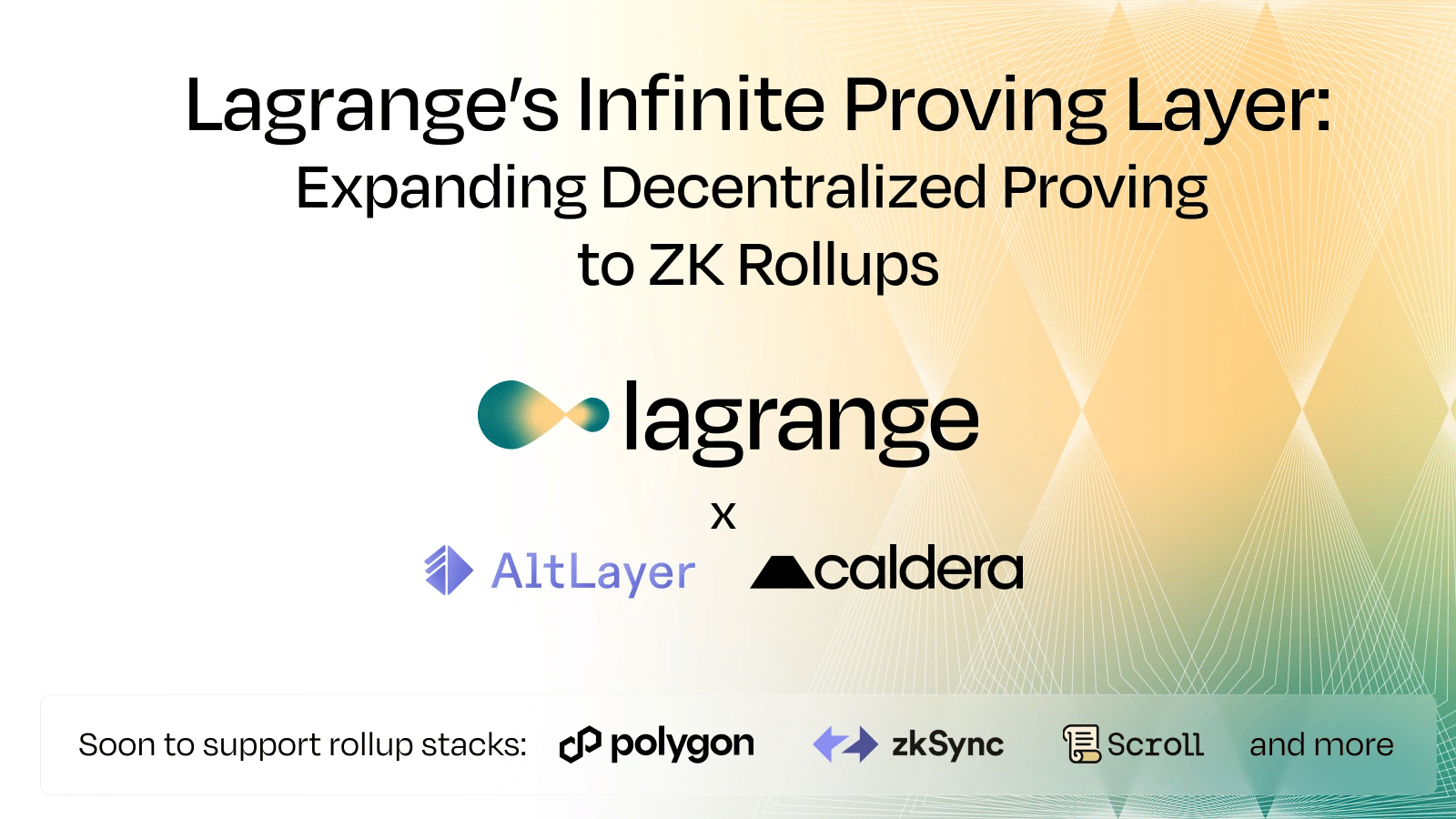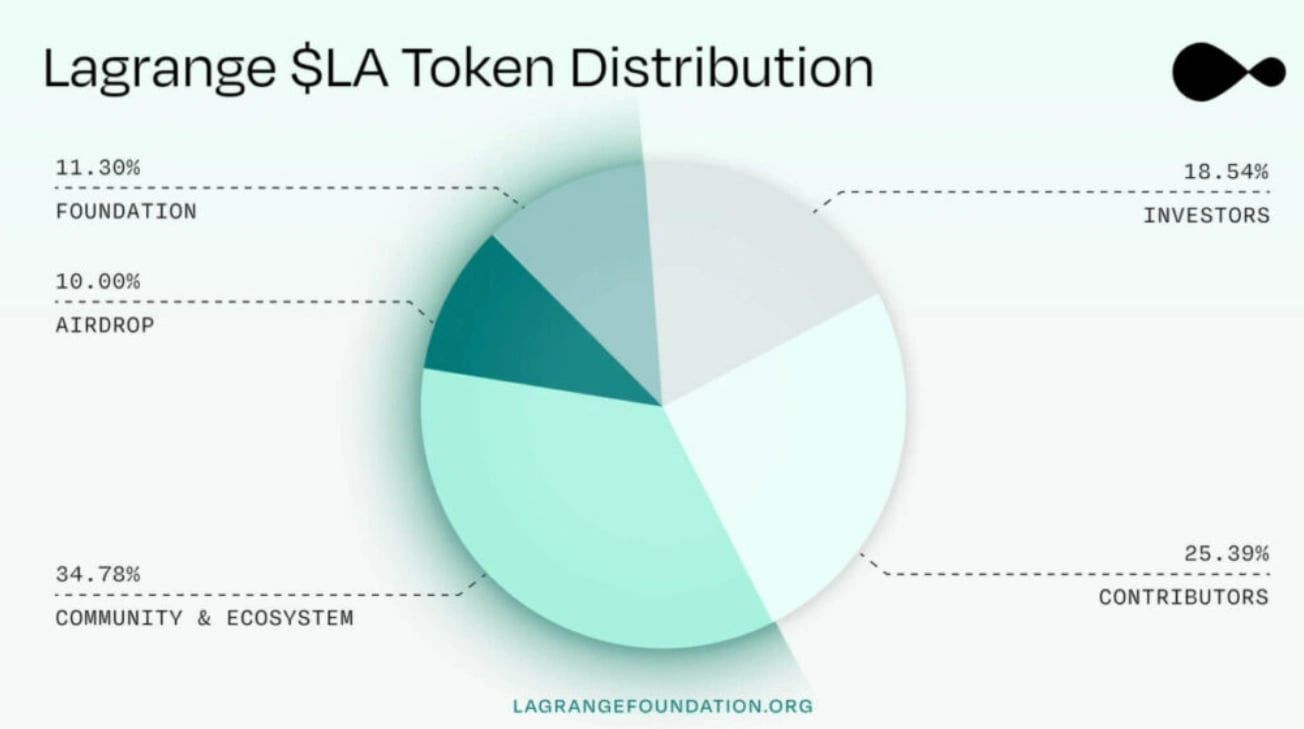订阅 wiki
Share wiki
Bookmark
Lagrange
Lagrange
Lagrange 是一个 区块链 基础设施项目,提供 零知识证明 (ZKP) 层,结合了去中心化的 ZK 证明者网络和 ZK 协处理器。其目的是为各种应用实现可扩展的密码学验证,包括 区块链 rollup 和人工智能 [1]。

概述
Lagrange 旨在解决 区块链 和 AI 验证领域中的关键挑战,特别是关于可扩展性、资源分配和可验证计算。其经济模型的核心组成部分是 $LA 代币,旨在协调网络参与者(客户端、证明者和代币持有者)的利益。该代币促进了证明请求的费用支付,并作为证明者的奖励机制,将证明需求直接与代币需求联系起来。Lagrange 还专注于扩展 智能合约 的能力,通过启用链下可验证的数据库查询和复杂计算,在链上进行验证,并将这种验证能力扩展到 AI 输出。 [1] [4]
Lagrange 基金会
Lagrange 基金会成立于 2025 年 5 月,是一个独立的实体,致力于 Lagrange 生态系统的发展 [2] [1]。它的任务是维护和管理 Lagrange 证明者网络,监督其日常运营 [2]。该基金会旨在促进 Lagrange 技术的重要用例的开发,包括可验证 AI、ZK Rollup 的可扩展性和协处理 [2]。生态系统项目可以期望从基金会获得业务发展、营销、技术指导和咨询服务等方面的支持 [2]。
Lagrange 基金会和 Lagrange Labs 是具有不同目标的不同组织 [2]。虽然 Lagrange Labs 作为 Lagrange 证明者网络的积极开发者,但它不持有任何治理职位或对网络运营的责任 [2]。Lagrange Labs 专注于新技术的研发,以扩展 ZK 证明生成和可验证 AI 的可扩展使用,这些努力的结果将应用于 Lagrange 证明者网络,以推动生态系统的发展 [2]。基金会的成立确保了可持续的治理和生态系统发展 [1]。
基于 EigenLayer 的 ZK 证明
Lagrange Labs 基于 以太坊 的 EigenLayer 再质押框架,以支持可扩展且信任最小化的零知识 (ZK) 计算。通过利用 EigenLayer 的再质押 ETH 来实现经济安全性,Lagrange 使 去中心化应用程序 能够将资源密集型计算卸载到由称为“协证明者”的链下 节点 网络。这些节点生成 ZK 证明,允许可验证的结果,而无需直接信任。凭借超过 60 亿美元的再质押资产来保护网络,Lagrange 的方法提高了大数据计算的性能,否则这些计算在链上效率低下。该团队继续使其基础设施与 EigenLayer 生态系统的发展保持一致。 [3]
ZK Rollups

Lagrange 扩展了其去中心化的 ZK 证明者网络,以支持零知识 (ZK) rollups,为 区块链 应用程序提供可扩展且抗审查的证明生成。这种扩展允许 rollups、应用程序和协处理器访问去中心化的证明基础设施,从而减轻了集中式证明生成(例如单点故障)的风险。Lagrange 将计算任务分配到独立的运营商网络中,为每个 rollup 提供专用带宽,并确保即使在高峰需求下也能实现高可用性。模块化的“网络中的网络”架构支持各种证明系统,并使链能够扩展而没有输入/输出限制。最初支持 AltLayer 和 Caldera,Lagrange 计划扩展到 zkSync、Polygon CDK 和 Scroll。借助此基础设施,Lagrange 促进了大规模的可验证计算,并通过单个证明请求界面简化了集成。 [4]
主要特点
- 模块化架构: 采用“网络中的网络”设计,旨在通过使用模块化子网络来提供可扩展性 [[1]](#cite-id-R9bi6i8kZF]。
- DARA 机制: 利用双重拍卖资源分配 (DARA) 系统来管理去中心化证明市场中的资源分配 [[1]](#cite-id-R9bi6i8kZF]。
- 通用 ZK 协处理器: 提供智能合约使用 SQL 查询和计算包含 区块链 数据子集的可证明数据库的功能 [[1]](#cite-id-R9bi6i8kZF]。这支持事务性 (OLTP) 和分析性 (OLAP) 工作负载 [[1]](#cite-id-R9bi6i8kZF]。
- 生产就绪的基础设施: 在 EigenLayer 上与 85 多个机构级运营商合作运营,旨在通过经济激励和对不履行行为的潜在削减惩罚来确保证明的活跃性 [[1]](#cite-id-R9bi6i8kZF]。
- 通用证明支持: 旨在支持各种证明系统,包括 Boojum、Plonky2 和 Plonky3 [[1]](#cite-id-R9bi6i8kZF]。
技术
Lagrange 的基础设施建立在两个主要组件之上:
- 去中心化 ZK 证明者网络: 负责生成零知识证明的证明者网络 [[1]](#cite-id-R9bi6i8kZF]。该网络的模块化设计允许专用带宽和对各种证明需求的支持 [[1]](#cite-id-R9bi6i8kZF]。
- 超并行 ZK 协处理器: 使智能合约能够使用密码学证明执行链下复杂数据库查询和计算 [[1]](#cite-id-R9bi6i8kZF]。它从 区块链 数据创建可证明的数据库,可以使用标准 SQL 进行查询 [[1]](#cite-id-R9bi6i8kZF]。
DARA(双重拍卖资源分配) 机制是一种用于在去中心化证明市场中分配资源的市場机制 [[1]](#cite-id-R9bi6i8kZF]。它旨在管理证明请求者和证明者之间的交互,旨在实现高效的资源分配和真实的投标 [[1]](#cite-id-R9bi6i8kZF]。
Lagrange 还包括 DeepProve,这是一种旨在通过允许用户请求 AI 输出正确性的密码学证明来实现可验证 AI 的技术 [[1]](#cite-id-R9bi6i8kZF]。
用例
- ZK Rollup 可扩展性: 为 ZK rollups 提供证明生成服务,以增强其可扩展性 [[1]](#cite-id-R9bi6i8kZF]。
- 可验证 AI: 通过 DeepProve,它可以使用密码学证明来验证 AI 计算和输出 [[1]](#cite-id-R9bi6i8kZF]。
- 跨链数据验证: ZK 协处理器允许智能合约处理和验证 跨 多个基于 EVM 的链的数据,而无需依赖桥 [[1]](#cite-id-R9bi6i8kZF]。这支持跨不同网络的平均值或分析等计算,并具有密码学保证 [[1]](#cite-id-R9bi6i8kZF]。
- 复杂智能合约计算: 促进智能合约的链下计算,这些计算可以在链上进行验证,支持复杂的应用程序,如 DeFi 协议或高级分析 [[1]](#cite-id-R9bi6i8kZF]。
代币经济学
Lagrange 代币 ($LA)
$LA 代币的总供应量为 1,000,000,000 个代币,固定年发行率为 4%,根据证明生成分配给证明者 [[1]](#cite-id-R9bi6i8kZF]。在代币生成事件 (TGE) 时,总供应量的 19.3% 立即可用 [[1]](#cite-id-R9bi6i8kZF]。
- 社区和生态系统:34.78% [[1]](#cite-id-R9bi6i8kZF]
- 贡献者:25.39% [[1]](#cite-id-R9bi6i8kZF]
- 投资者:18.54% [[1]](#cite-id-R9bi6i8kZF]
- 基金会:11.30% [[1]](#cite-id-R9bi6i8kZF]
- 空投:10.00% [[1]](#cite-id-R9bi6i8kZF]
分配给早期贡献者和投资者的代币在 TGE 后锁定一年。此后,早期贡献者和投资者将在两年内线性解锁 [[1]](#cite-id-R9bi6i8kZF]。分配给社区和生态系统的代币在 TGE 时最初解锁了总供应量的 5% [[1]](#cite-id-R9bi6i8kZF]。社区和生态系统代币的剩余部分被锁定 6 个月,然后进行 48 个月的线性解锁 [[1]](#cite-id-R9bi6i8kZF]。

代币效用
- 费用支付: 它是用于支付 Lagrange 网络内证明生成请求费用的原生货币 [[1]](#cite-id-R9bi6i8kZF]。
- 证明者激励: 证明者完全以 $LA 代币获得补偿,无论原始支付货币如何 [[1]](#cite-id-R9bi6i8kZF]。
- 质押和委托: 代币持有者可以将 $LA 质押或委托给特定的证明者,将排放补贴导向以降低所选运营商的证明成本 [[1]](#cite-id-R9bi6i8kZF]。这种机制充当二级供应水槽,减少 流通供应,同时允许利益相关者影响网络经济优先级 [[1]](#cite-id-R9bi6i8kZF]。
- 网络安全: 质押 机制锁定代币并为网络安全创造经济激励 [[1]](#cite-id-R9bi6i8kZF]。证明者必须保持性能标准,否则将面临潜在的削减,而委托者根据其选择的证明者的表现分享奖励 [[1]](#cite-id-R9bi6i8kZF]。
发现错误了吗?
